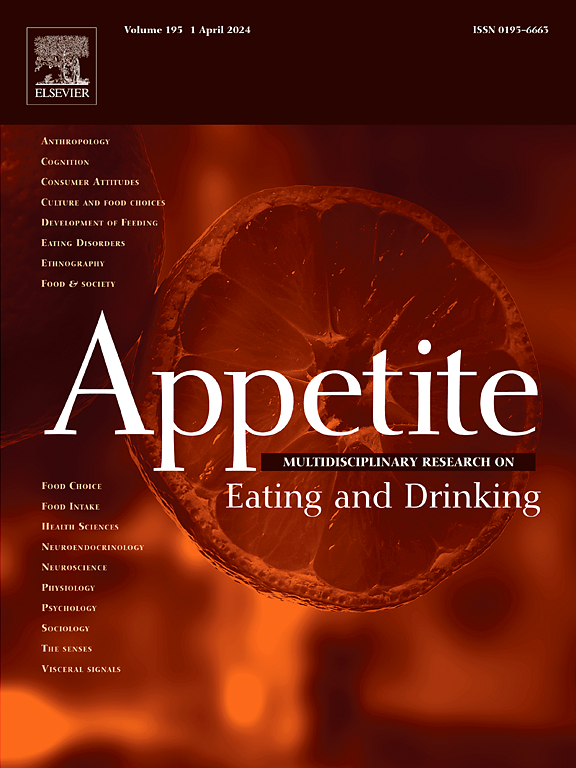停车、思考、购买:一项在线随机对照实验,比较红绿灯营养标签和价格促销对引导消费者食品选择的影响
IF 3.8
2区 医学
Q1 BEHAVIORAL SCIENCES
引用次数: 0
摘要
与饮食有关的疾病是一个全球性的健康问题,促使各国政府在全民范围内实施饮食改善措施。在英国,营养标签的红绿灯系统(TLS)旨在指导人们选择更健康的食物。然而,人们担心零售商的价格促销是否会抵消TLS对饮食的积极影响。为了解决这些问题,在本研究中,我们调查了TLS和价格促销对食品选择健康的影响,无论是单独的还是联合的。预先注册的在线随机对照试验(RCT)采用2x3因子受试者间设计,采用TLS(对照vs TLS)和价格促销(无促销vs最健康产品促销vs最不健康产品促销)作为干预措施。共有1582名英国参与者被随机分配到不同的实验条件下,并被要求在四种不同健康程度的无品牌小吃店中做出假设的购买选择。研究发现,价格促销有效地增加了人们选择促销产品的可能性,无论这些产品是健康的还是不健康的。研究发现,不健康食品的价格促销降低了人们选择最健康食品的可能性。与对照组相比,TLS标签对食物选择没有显著影响。然而,标签有一种倾向,即扩大价格促销对健康产品的影响,抑制对不健康产品的影响。总的来说,我们的研究为在零售环境中实施多种政策干预时不同力量如何相互作用提供了新的见解,并强调了将它们结合起来进行检查的必要性。本文章由计算机程序翻译,如有差异,请以英文原文为准。
Stop, think, buy: An online randomised controlled experiment comparing the effects of traffic light nutritional labelling and price promotion on steering consumer food choice
Diet-related diseases are a global health concern, prompting governments to implement population-wide dietary improvements. In the UK, the traffic light system (TLS) of nutritional labelling aims to guide healthier food choices. However, concerns have arisen about whether retailer price promotions may counteract positive effects of the TLS on diet. To address these concerns, in the present research we investigated the effects of the TLS and price promotions on the healthiness of food choice, both individually and in combination. A pre-registered online randomised controlled trial (RCT) was conducted using a 2x3 factorial between-subjects design with TLS (control vs. TLS) and price promotion (no promotion vs. healthiest product promotion vs. unhealthiest product promotion) as interventions. A total of 1582 UK participants were randomised across the experimental conditions and asked to make a hypothetical purchase choice amongst four unbranded snack bars of varying healthiness. Price promotions were found to effectively increase the likelihood of choosing a promoted product, whether healthy or unhealthy. Price promotions on the unhealthiest food item were found to decrease the likelihood of the healthiest product being chosen. TLS labelling did not significantly impact food choice relative to the control. However, there was a tendency for the labelling to amplify the effect of price promotions on healthy products and dampen the effect on unhealthy products. Overall, our research offers new insights into how different forces may interact when multiple policy interventions are implemented in the retail environment and highlights the need to examine them in combination.
求助全文
通过发布文献求助,成功后即可免费获取论文全文。
去求助
来源期刊

Appetite
医学-行为科学
CiteScore
9.10
自引率
11.10%
发文量
566
审稿时长
13.4 weeks
期刊介绍:
Appetite is an international research journal specializing in cultural, social, psychological, sensory and physiological influences on the selection and intake of foods and drinks. It covers normal and disordered eating and drinking and welcomes studies of both human and non-human animal behaviour toward food. Appetite publishes research reports, reviews and commentaries. Thematic special issues appear regularly. From time to time the journal carries abstracts from professional meetings. Submissions to Appetite are expected to be based primarily on observations directly related to the selection and intake of foods and drinks; papers that are primarily focused on topics such as nutrition or obesity will not be considered unless they specifically make a novel scientific contribution to the understanding of appetite in line with the journal's aims and scope.
 求助内容:
求助内容: 应助结果提醒方式:
应助结果提醒方式:


